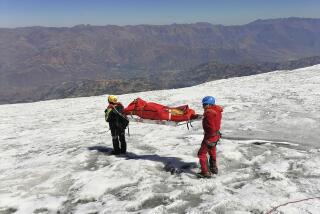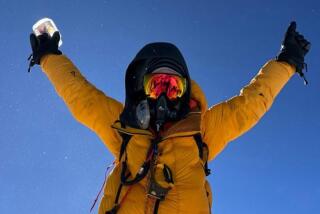Perilous North Pole Expedition : Trekkers Relate Grueling Trip to Top of the World
WASHINGTON — After their March 8 departure, they encountered temperatures as low as 71 degrees below zero and tall ridges of ice that continually blocked the way of their heavily laden sleds, which carried thousands of pounds of supplies.
But, 55 days later, a frostbitten, fatigued team of five men, one woman and 20 dogs finally reached the North Pole to become the first unsupported expedition to reach there by dog sled since Adm. Robert E. Peary stood there in 1909.
“It was an incredibly hard experience,” said Will Steger, the expedition leader. “In my 23 years of travel in the Arctic, these were the worst conditions I’ve been in.”
Steger, 41, appeared at a news conference here Tuesday with Paul Schurke, 30, both of Ely, Minn., and Ann Bancroft, 30, a schoolteacher from Sunfish Lake, Minn., who became the first woman to complete the unsupported trek to the pole.
The circles under their eyes, their weather-beaten skin and the deep frostbitten patch on Schurke’s bearded chin were sure signs of the grueling physical and mental undertaking that they completed May 1.
When the Steger International Polar Expedition began at Ward Hunt Island--the northernmost tip of North America--to follow Peary’s route to the pole, there were eight team members and 49 dogs. But, along the way, two team members had to be airlifted out after one suffered crushed ribs in a sled accident and the other developed frostbitten toes. One dog died, and another 20 were flown out as three of five sleds were emptied of supplies and burned for heat.
On bad days, they were stopped by “whiteouts” of blinding snow; on good days, they conquered the ice ridges and freezing water. On their best day, they accomplished 38 miles.
But, after nightfall, none of it was good. The trekkers slept in sleeping bags in tents with temperatures down to 40 degrees below zero. It was so cold that they had to warm vital batteries in teapots of boiling water.
Their daily diet of 70% fat consisted of about 7,000 calories and ranged from a porridge of oats and butter for breakfast to a stew of egg noodles and dried meat and fat for dinner. The dogs also ate special food.
Fell Into Freezing Water
At one point, Bancroft fell into the freezing water--and the chill, she said, did not begin to wear off until two days later.
“Being the only woman, I would be lying if I said it was easy all the time,” she said. “There were some lonely moments when it would have been nice if the ratio (of men to women) had been a little more equal.”
However, she added cheerfully, “it’s definitely not a man’s world up there. We’re perfectly capable of enduring cold, if not better, since we have that nice fat reserve that some of the men don’t have.”
To Bancroft and the others on the trek, the “real unsung heroes” were the dogs. “They did the brunt of the work. They’re incredible,” she said.
For that reason, also in attendance at Tuesday’s press conference was Zap, a 9-year-old Alaskan husky with 11,000 miles of Arctic experience, who was forced to leave the expedition early because of a paw injury.
Near the end of the long journey, when supplies ran dangerously low and the dogs were losing energy, the trekkers decided to increase the animals’ food and lighten their supply load as much as possible, even sleeping with three people in two sleeping bags.
‘Never Certain’ of Goal
“Mentally, we were never certain we would reach the North Pole until the last day,” said Steger, who operates a school with Schurke in Ely that teaches winter survival skills.
With no solid ground or landmarks at the North Pole--only constantly moving ice atop a deep ocean--the expedition was not sure it had reached its goal. But the last reading of their sextant placed them less than one-tenth of a degree from the Pole. Their position was confirmed three times by satellite readings and by three airplanes.
They stayed a day and were airlifted out. But they left behind a sign of their conquest, a time capsule that Schurke said is signed by the expedition members and contains various items ranging from a Boy Scout flag to a child’s letter to Santa Claus.
And the group statement read upon their arrival indicates that, in spite of it all, their spirits did not fade:
“As we six adventurers from different parts of the world stand here at the lines of longitude where all the countries meet, we believe this journey stands for hope that other seemingly impossible goals can be met by people everywhere.”
More to Read
Sign up for Essential California
The most important California stories and recommendations in your inbox every morning.
You may occasionally receive promotional content from the Los Angeles Times.










